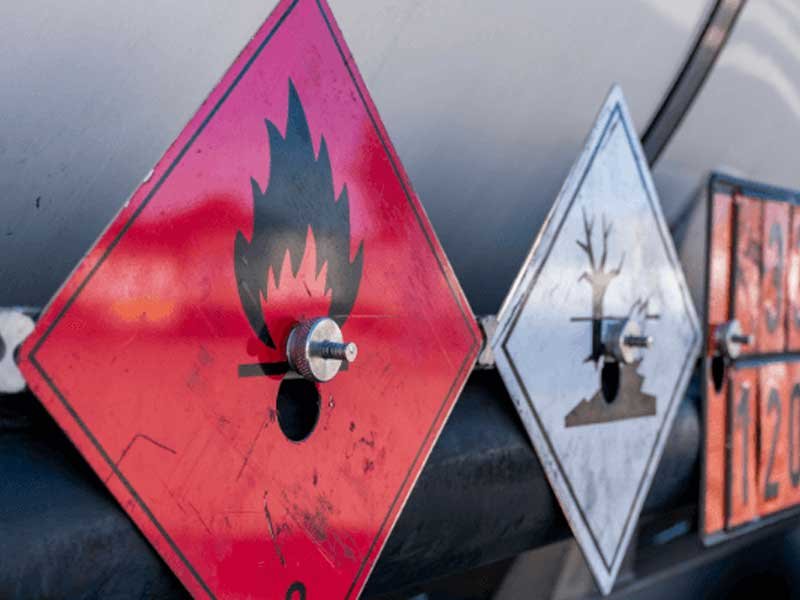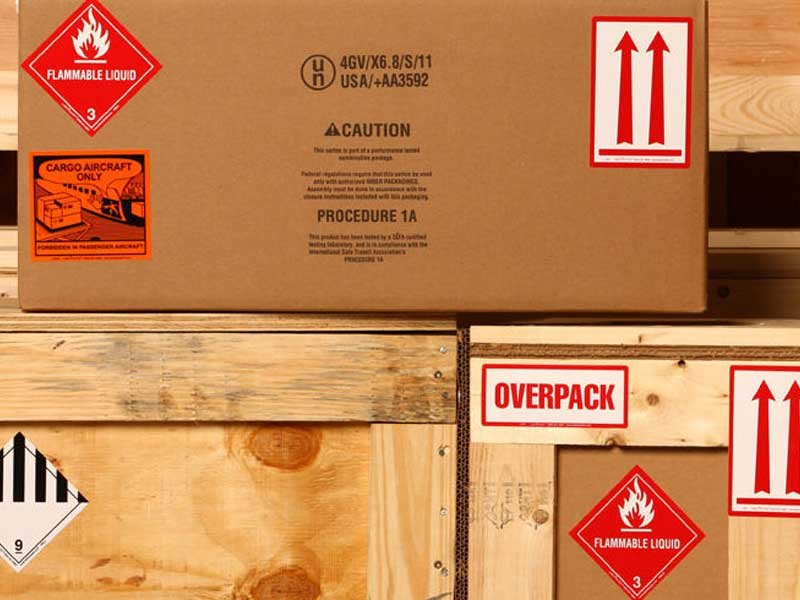
Dangerous goods shipping is a critical component of global trade, involving the transportation of materials that pose risks to health, safety, property, or the environment. These materials range from flammable liquids and explosives to toxic chemicals and radioactive substances. The complexity of shipping dangerous goods lies in the need to balance the facilitation of trade with stringent safety measures to prevent accidents and environmental harm.
Types of Dangerous Goods
Dangerous goods, also known as hazardous materials (hazmat), encompass a wide range of substances that present risks to health, safety, property, or the environment during transportation. These materials are classified into nine classes based on their specific properties and the hazards they pose:
Explosives (Class 1)
This class includes items that have the potential to cause explosions due to their chemical reactions or physical properties. Examples include fireworks, ammunition, dynamite, and blasting agents used in mining and construction.
Gases (Class 2)
Gases are substances that can exist in a gaseous state at normal temperatures and pressures. They are further categorized into flammable gases (e.g., propane, butane), non-flammable gases (e.g., nitrogen, helium), and toxic gases (e.g., chlorine, ammonia).
Flammable Liquids (Class 3)
Flammable liquids are substances that can ignite and burn easily at relatively low temperatures. Common examples include gasoline, alcohol, acetone, and paint thinners.
Flammable Solids (Class 4)
Flammable solids are materials that can ignite spontaneously or when exposed to heat, friction, or other ignition sources. Examples include matches, magnesium, sulfur, and certain types of metal powders.
Oxidizing Substances and Organic Peroxides (Class 5)
Oxidizing substances and organic peroxides are materials that can cause or promote the combustion of other substances by releasing oxygen or other oxidizing agents. Examples include hydrogen peroxide, ammonium nitrate, and potassium permanganate.
Toxic and Infectious Substances (Class 6)
This class includes materials that are capable of causing harm to living organisms, either through chemical means (toxic substances) or by spreading infectious diseases (infectious substances). Examples include cyanides, pesticides, medical waste, and biological samples.
Radioactive Materials (Class 7)
Radioactive materials emit radiation and can cause damage to living organisms and the environment. This class includes items such as uranium, medical isotopes used in diagnostics and treatment, and nuclear fuel used in power generation.
Corrosives (Class 8)
Corrosives are substances that can cause severe damage to living tissue, metals, and other materials upon contact. Examples include battery acid (sulfuric acid), hydrochloric acid, sodium hydroxide (lye), and certain cleaning agents.
Miscellaneous Dangerous Goods (Class 9)
This class encompasses hazardous substances that do not fit into the other eight classes but still pose risks during transportation. Examples include dry ice (solid carbon dioxide), asbestos, lithium batteries, and genetically modified organisms (GMOs).
Read more: Freight Charges & Freight Fees
Regulatory Framework
The shipping of dangerous goods is governed by a robust international regulatory framework designed to minimize risks and ensure safety. The key regulations include:
International Maritime Dangerous Goods (IMDG) Code: Developed by the International Maritime Organization (IMO), this code provides guidelines for the safe transport of dangerous goods by sea.
International Air Transport Association (IATA) Dangerous Goods Regulations (DGR): These regulations govern the transport of hazardous materials by air, ensuring safety and compliance with international standards.
United Nations Recommendations on the Transport of Dangerous Goods: Also known as the UN Model Regulations, these guidelines serve as a basis for harmonizing regulations across different modes of transport.

Packaging and Labeling
Proper packaging and labeling are crucial to ensure the safe transportation of dangerous goods. Packaging must be durable, leak-proof, and resistant to the material’s properties. It often involves multiple layers of containment to prevent leaks and spills.
Labels and placards are used to identify the type of hazardous material and its associated risks. They include hazard symbols, UN identification numbers, and handling instructions. These labels provide vital information to handlers and emergency responders.
Documentation and Compliance
Accurate documentation is essential for the shipping of dangerous goods. Key documents include:
Shipper’s Declaration for Dangerous Goods: This document certifies that the shipment complies with all regulations.
Material Safety Data Sheet (MSDS): Provides detailed information about the substance, including its hazards and safety precautions.
Transport Documents: Include the bill of lading or air waybill, which details the shipment’s contents and handling instructions.
Compliance with regulations is mandatory. Failure to comply can result in severe penalties, including fines, legal action, and the suspension of shipping privileges.
Training and Safety Measures
Proper training for personnel handling dangerous goods is critical. Training programs cover the classification of hazardous materials, packaging and labeling requirements, emergency response procedures, and the use of protective equipment.
Safety measures include:
Regular Inspections: Ensuring that packaging, labeling, and documentation meet regulatory standards.
Emergency Response Plans: Preparing for potential accidents or spills during transit.
Protective Gear: Using appropriate safety equipment, such as gloves, masks, and goggles, to protect workers from exposure.
Read more: Logistic Companies in Iran
Importance of Proper Handling and Transportation
The proper handling and transportation of dangerous goods are paramount to ensure the safety of individuals, the environment, and property. Mishandling or inadequate packaging of hazardous materials can lead to accidents, spills, and environmental contamination, posing significant risks to human health and ecosystems.

Classification of Dangerous Goods
Dangerous goods are classified into nine categories based on their specific properties and the risks they pose. Understanding these classifications is essential for ensuring appropriate packaging, labeling, and transportation:
- Explosives
- Gases
- Flammable Liquids
- Flammable Solids
- Oxidizing Substances and Organic Peroxides
- Toxic and Infectious Substances
- Radioactive Materials
- Corrosives
- Miscellaneous Dangerous Goods
- Regulations and Compliance
The shipping of dangerous goods is subject to strict regulations and international standards to mitigate risks and ensure safety. Key regulatory frameworks include the International Maritime Dangerous Goods (IMDG) Code, the International Air Transport Association (IATA) Dangerous Goods Regulations (DGR), and the United Nations Recommendations on the Transport of Dangerous Goods. Compliance with these regulations is mandatory and requires thorough documentation, proper packaging, labeling, and training of personnel.
Packaging and Labeling Requirements
Proper packaging and labeling are critical components of dangerous goods shipping. Packaging must be robust, leak-proof, and resistant to the properties of the hazardous material. Labels and placards are used to identify the type of material, its associated risks, and handling instructions. Adhering to strict packaging and labeling requirements ensures the safe transportation of dangerous goods.
Training and Safety Measures for Personnel
Training programs for personnel handling dangerous goods cover various aspects, including classification, packaging, labeling, and emergency response procedures. Regular inspections, emergency response plans, and the use of protective gear are essential safety measures to prevent accidents and minimize risks during transportation.
Conclusion
The shipping of dangerous goods is a complex but essential aspect of global trade, requiring meticulous attention to safety regulations, packaging, labeling, and documentation. By adhering to international standards and ensuring rigorous training and compliance, the transportation of hazardous materials can be conducted safely, protecting both people and the environment. As global trade continues to expand, the importance of maintaining these high standards in dangerous goods shipping cannot be overstated.
Read more: Air Freight
FAQs
Dangerous goods, also known as hazardous materials or hazmat, are substances that pose risks to health, safety, property, or the environment during transportation. These include explosives, flammable liquids, toxic chemicals, and radioactive materials.
Proper handling of dangerous goods is essential to prevent accidents, spills, and environmental contamination. Mishandling or inadequate packaging can lead to serious risks to human health, ecosystems, and property.
Dangerous goods shipping is subject to strict regulations and international standards, including the International Maritime Dangerous Goods (IMDG) Code, the International Air Transport Association (IATA) Dangerous Goods Regulations (DGR), and the United Nations Recommendations on the Transport of Dangerous Goods.
Packaging for dangerous goods must be robust, leak-proof, and resistant to the properties of the hazardous material. Labels and placards are used to identify the type of material, its risks, and handling instructions, ensuring safe transportation.
Personnel handling dangerous goods require comprehensive training covering classification, packaging, labeling, and emergency response procedures. Regular inspections, emergency response plans, and the use of protective gear are crucial for preventing accidents and minimizing risks during transportation.


